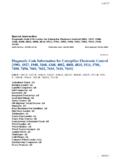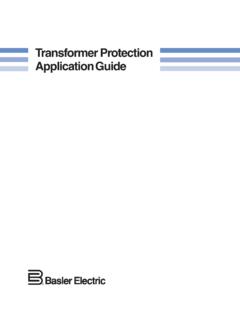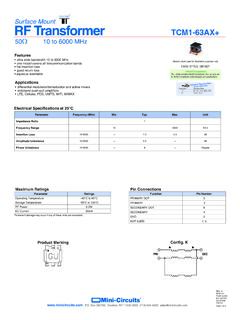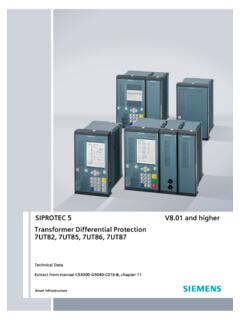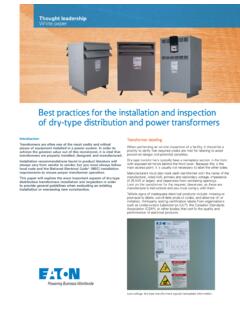Transcription of MT-019: DAC Interface Fundamentals - Analog Devices
1 , 10/08, WK Page 1 of 14 MT-019 TUTORIAL DAC Interface Fundamentals by Walt Kester INTRODUCTION This tutorial outlines some important issues regarding DAC Interface circuitry including the voltage reference, Analog output, data input, and clock driver. Because ADCs require references and clocks also, most of the concepts presented in this tutorial regarding these subjects apply equally to ADCs. DAC REFERENCE VOLTAGE There is a tendency to regard DACs simply as Devices with digital inputs and an Analog output. But the Analog output depends on the presence of that Analog input known as the reference, and the accuracy of the reference is almost always the limiting factor on the absolute accuracy of a DAC. Design tools such as the Voltage Reference Wizard are useful is matching references to data converters. These tools and others are available on the Design Center portion of the Analog Devices ' website.
2 Some ADCs and DACs have internal references, while others do not. Some ADCs use the power supply as a reference. Unfortunately, there is little standardization with respect to ADC/DAC voltage references. In some cases, the dc accuracy of a converter with an internal reference can often be improved by overriding or replacing the internal reference with a more accurate and stable external one. In other cases, the use of an external low-noise reference will also increase the noise-free code resolution of a high-resolution ADC. Various ADCs and DACs provide the capability to use external references in lieu of internal ones in various ways. Figure 1 shows some of the popular configurations (but certainly not all). Figure 1A shows a converter which requires an external reference. It is generally recommended that a suitable decoupling capacitor be added close to the ADC/DAC REF IN pin.
3 The appropriate value is usually specified in the voltage reference data sheet. It is also important that the reference be stable with the required capacitive load (more on this to come). Figure 1B shows a converter that has an internal reference, where the reference is also brought out to a pin on the device. This allows it to be used other places in the circuit, provided the loading does not exceed the rated value. Again, it is important to place the capacitor close to the converter pin. If the internal reference is pinned out for external use, its accuracy, stability, and temperature coefficient is usually specified on the ADC or DAC data sheet. MT-019 INTREFINTREFEXTREFREFOUTREF OUTREF ININTREFEXTREFREF OUT/INRCCCADC/DACADC/DACADC/DAC(A)(B)(C) INTREFREF OUTREF INCADC/DACINTREFREF OUT/INRADC/DACC(D)(E)REF INCADC/DACEXTREF(F) Figure 1: Some Popular ADC/DAC Reference Options If the reference output is to be used other places in the circuit, the data sheet specifications regarding fanout and loading must be strictly observed.
4 In addition, care must be taken in routing the reference output to minimize noise pickup. In many cases, a suitable op amp buffer should be used directly at the REF OUT pin before fanning out to various other parts of the circuit. Figure 1C shows a converter which can use either the internal reference or an external one, but an extra package pin is required. If the internal reference is used, as in Figure 1C, REF OUT is simply externally connected to REF IN, and decoupled if required. If an external reference is used as shown n Figure 1D, REF OUT is left floating, and the external reference decoupled and applied to the REF IN pin. This arrangement is quite flexible for driving similar ADCs or DACs with the same reference in order to obtain good tracking between the Devices . Figure 1E shows an arrangement whereby an external reference can override the internal reference using a single package pin.
5 The value of the resistor, R, is typically a few k , thereby allowing the low impedance external reference to override the internal one when connected to the REF OUT/IN pin. Figure 1F shows how the external reference is connected to override the internal reference. The arrangements shown in Figure 1 are by no means the only possible configurations for ADC and DAC references, and the individual data sheets should be consulted in all cases for details regarding options, fanout, decoupling, etc. Page 2 of 14 MT-019 Although the reference element itself can be either a bandgap, buried zener, or XFET , practically all references have some type of output buffer op amp. The op amp isolates the reference element from the output and also provides drive capability. However, this op amp must obey the general laws relating to op amp stability, and that is what makes the topic of reference decoupling relevant to the discussion.
6 Note that a reference input to an ADC or DAC is similar to the Analog input of an ADC, in that the internal conversion process can inject transient currents at that pin. This requires adequate decoupling to stabilize the reference voltage. Adding such decoupling might introduce instability in some reference types, depending on the output op amp design. Of course, a reference data sheet may not show any details of the output op amp, which leaves the designer in somewhat of a dilemma concerning whether or not it will be stable and free from transient errors. In many cases, the ADC or DAC data sheet will recommend appropriate external references and the recommended decoupling network. A well-designed voltage reference is stable with heavy capacitive decoupling. Unfortunately, some are not, and larger capacitors actually increases the amount of transient ringing.
7 Such references are practically useless in data converter applications, because some amount of local decoupling is almost always required at the converter. A suitable op amp buffer might be added between the reference and the data converter. However, there are many good references available which are stable with an output capacitor. This type of reference should be chosen for a data converter application, rather than incurring the further complication and expense of an op amp. DAC Analog OUTPUT CONSIDERATIONS The Analog output of a DAC may be a voltage or a current. In either case it may be important to know the output impedance. If the voltage output is buffered, the output impedance will be low. Both current outputs and unbuffered voltage outputs will be high(er) impedance and may well have a reactive component specified as well as a purely resistive one. Some DAC architectures have output structures where the output impedance is a function of the digital code on the DAC this should be clearly noted on the data sheet.
8 In theory, current outputs should be connected to zero ohms at ground potential. In real life they will work with non-zero impedances and voltages. Just how much deviation they will tolerate is defined under the heading "compliance" and this specification should be heeded when terminating current-output DACs. Most high-speed DACs suitable for video, RF, or IF, have current outputs which are designed to drive source and load-terminated cables directly. For instance, a 20-mA current output DAC can develop V across a 25- load (the equivalent dc resistance of a 50- source and load terminated cable). In most cases, single-supply high-speed CMOS DACs have a positive output compliance of at least +1 V and a negative output compliance of a few hundred millivolts. Page 3 of 14 MT-019In many cases, such as the TxDAC family, both true and complementary current outputs are available.
9 The differential outputs can drive the primary winding of a transformer directly, and a single-ended signal can be developed at the secondary winding by grounding one side of the output winding. This method will often give better distortion performance at high frequencies than simply taking the output signal directly from one of the DAC current outputs and grounding the other. Modern current output DACs usually have differential outputs, to achieve high common-mode rejection and reduce the even-order distortion products. Fullscale output currents in the range of 2 mA to 30 mA are common. In many applications, it is desirable to convert the differential output of the DAC into a single-ended signal, suitable for driving a coax line. This can be readily achieved with an RF transformer, provided low frequency response is not required. Figure 2 shows a typical example of this approach.
10 The high impedance current output of the DAC is terminated differentially with 50 , which defines the source impedance to the transformer as 50 . The resulting differential voltage drives the primary of a 1:1 RF transformer, to develop a single-ended voltage at the output of the secondary winding. The output of the 50- LC filter is matched with the 50- load resistor RL, and a final output voltage of 1-Vp-p is developed. LCFILTERMINI-CIRCUITSADT1-1WT1:1 RDIFF= 50 RLOAD= 50 VLOAD= TO 20mA20 TO 0mA 10mACMOSDAC Figure 2: differential Transformer Coupling The transformer not only serves to convert the differential output into a single-ended signal, but it also isolates the output of the DAC from the reactive load presented by the LC filter, thereby improving overall distortion performance. An op amp connected as a differential to single-ended converter can be used to obtain a single-ended output when frequency response to dc is required.











